


Preliminary stuff
| IMAGE | TRANSITION | Time | DIALOGUE |
 |
cut | 0.30 | tone |
 |
cut | 0.15 | tone |
 |
cut | 0.15 | - |
Introduction 00:01.35
| IMAGE | TRANSITION | Time | DIALOGUE |
 |
fade from black | 0.05 | - |
| dissolve
to this |
0.15 | (Chicago city sounds from earthworld low
in background)
Welcome to the Round Earth project at the University of Illinois at Chicago. Here in Illinois, the Earth looks pretty flat, and like most young children, young Illinois children believe the Earth IS flat. |
|
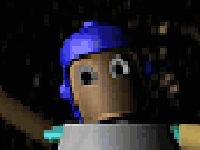 simulator:avatar
on the surface of the asteroid - simulator:avatar
on the surface of the asteroid -
(each shot in this sequence pulls further back from the astronaut) |
dissolve
to this |
0:15 | The spherical Earth is a simple example of a 'deep idea' - a fundamental concept that lies underneath our extensive systems of domain knowledge and influences how experience and discourse are conceptualized. |
 simulator:avatar
on the surface of the asteroid - torso shot, rocks in background simulator:avatar
on the surface of the asteroid - torso shot, rocks in background |
dissolve
to this |
0.20 | The acquisition of deep ideas, deep learning, involves a paradox - while the intent is to replace the learner's existing ideas, those exisiting ideas are the learner's main tools for assimilating the new idea. The typical outcome of trying to replace these ideas with more fundamental ideas is distortion. |
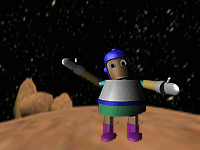 simulator:avatar
on the surface of the asteroid - full body shot simulator:avatar
on the surface of the asteroid - full body shot |
dissolve
to this |
0.25 | Because of this, deep learning may require
an alternative congitive starting point, where the new concept can be learned
independant of the conflicting prior experience. We are using Virtual Reality
to help generate this alternative starting point.
For learning about the sphericality of the Earth the children can start off on a small asteroid like this one. |
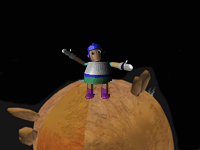 simulator:view
of avatar on an obviously spherical asteroid with a small but visible astronaut simulator:view
of avatar on an obviously spherical asteroid with a small but visible astronaut |
dissolve
to this |
0.15 | Here the children can experience walking around a sphere and coming back to where they started. They can see objects appear quickly from over the horizon. They can stand 'on the bottom' and not fall off. |
Body 00:01.35+kids dialogue (10-15)
| IMAGE | TRANSITION | Time | DIALOGUE |
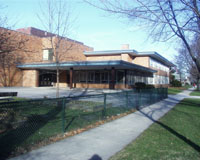
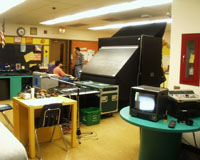
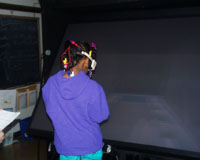 still picture of school
dissolving to still picture of room dissolving to still picture of kid
in front of desk (to kind of match the desk footage shown after the next
dissolve) still picture of school
dissolving to still picture of room dissolving to still picture of kid
in front of desk (to kind of match the desk footage shown after the next
dissolve) |
dissolve
to this |
0.10 | With the cooperation of the principal, staff,
and teachers, we brought an Immersadesk into a local elementary school
to investigate this approach.
|
 simulator of idesk screen
- POV shot of a person walking around the surface of the asteroid simulator of idesk screen
- POV shot of a person walking around the surface of the asteroid |
dissolve
to this |
0.25 | A pair of children collaborate in this learning activity on the asteroid.
Their mission is to collect enough fuel cells from the surface to allow
their stranded spaceship to leave. Neither child can complete the task
alone - they must cooperate.
One child acting as the astronaut explores the surface of the asteroid from the Immersadesk. |
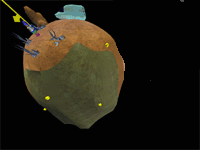 simulator
of monitor screen - watching the avatar walk around the surface of the
asteroid simulator
of monitor screen - watching the avatar walk around the surface of the
asteroid |
dissolve
to this |
0.20 | The second child acting as mission control
guides the first child from a stereo monitor.
This child sees the asteroid as a sphere with the astronaut and the fuel cells visible on its surface. The astronaut may be visibly 'upside down' to this child while the astronaut is always 'rightside up' at the immersadesk |
| splitscreen CG recreation of live split screen shot from the school (ie monoscopic direct footage dump rather than using the videocameras) | dissolve
to this |
<0.10 | The children talk to each other, and must integrate their different views of the asteroid to complete their mission. |
| continuation of previous | continues | ? | appropriate kids dialogue |
| continuation of previous | continues | <0.10 | After 10 minutes the children switch roles to experience the asteroid from the other perspective |
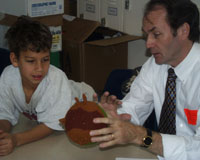 live
shot of bridging activities with the asteroid model - either with a kid
or a redone version without a kid (strange looking I'm sure) live
shot of bridging activities with the asteroid model - either with a kid
or a redone version without a kid (strange looking I'm sure) |
dissolve
to this |
0.20 | Once the children have completed their mission,
bridging activities are used to relate this new experience on the asteroid
back to their everyday experience on the Earth
This structured dialogue prompts reflection on the VR experience using physical models of the asteroid and the Earth |
time is 3.10+0.10 at this point
Results 00:01.15
| IMAGE | TRANSITION | Time | DIALOGUE |
| - montage of still images from tests? or use live footage from a pre or post-test? how about actual drawings from post test? | dissolve to this | 0.30 | The children are interviewed before and after
the experience. The questions probe their understanding of the shape of
the Earth and the implications of that fact such as the relativity of up
and down, occlusion by curvature, and circumnavigation
These questions are asked 3 ways: verbally, using 2 dimensional drawings, and using 3 dimensional playdoh, to minimize representational bias. |
| continue from previous | continue from
previous |
0.15 | Our initial studies show significant improvement in the treatment group between the pre-test and the post-test, allowing them to catch up with their classmates who had acquired the concept. |

grey version of logo or ??do another montage of the kids like in NICE video - maybe another mix of CG and live photos |
fade to dark
logo on black |
0.30 | Tele-Immersive virtual environments such
as this one have great potential for encouraging jigsawed collaboration
and enhancing understanding through multiple representations and viewpoints
We are continuing to focus on learning goals that meet 3 criteria - they be important. - they must be hard. - and they must be plausibly enhanced by immersive VR These environments must be informed by contemporary research in the learning sciences and educational practice, and will be built with the close cooperation of teachers |
time is 4.25+0.10 at this point
Credits 00:00.15
| IMAGE | TRANSITION | Time | DIALOGUE |
| showcase images white text on faded round earth logo (maybe grey/silver, remains common) | fade from black or logo | 0.02 | |
| The complete Round Earth Project team is Joe Alexander, Tom DeFanti, Mark Gillingham, Josh Hemmerich, Jyoti Jain, Andrew Johnson, Tom Moher, Mark Orr, Stellan Ohlsson, Carlos Orrego, Maria Roussos, and Mike Trolio. | cut | 0.02 | maybe some dialogue from the kids? (your other right, that was coool, etc) |
| With the assistance of Julieta Aguilera, Josephine Anstey, Jim Costigan, Greg Dawe, Tom Frisch, Steve Jones, Jason Leigh, Dave Pape, Sam Thongrong, and Fang Wang. | cut | 0.02 | - continues from previous |
| This research was supported by funding from
the National Science Foundation, award EIA 9720351 - Deep Learning and
Visualization Technologies.
The CAVE and ImmersaDesk are trademarks of the Board of Trustees of the University of Illinois. |
cut | 0.02 | - continues from previous |
| Wish special thanks to the teachers, staff, and students at Lincoln
Elementary, Oak Park, IL
for more information see:
|
cut | 0.02 | - continues from previous |
 |
fade to black | fade out |
time is 4.40+0.10 at his point
need to record audio by first week of feb,preferably last week of january
record video on 2nd week of feb
mix it weeks 3 and 4 of february
1 week leeway at the end before showing it at IEEE VR